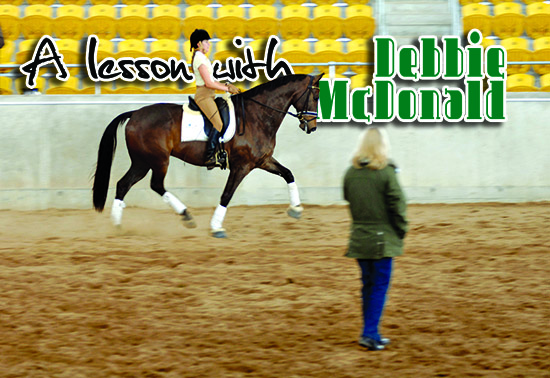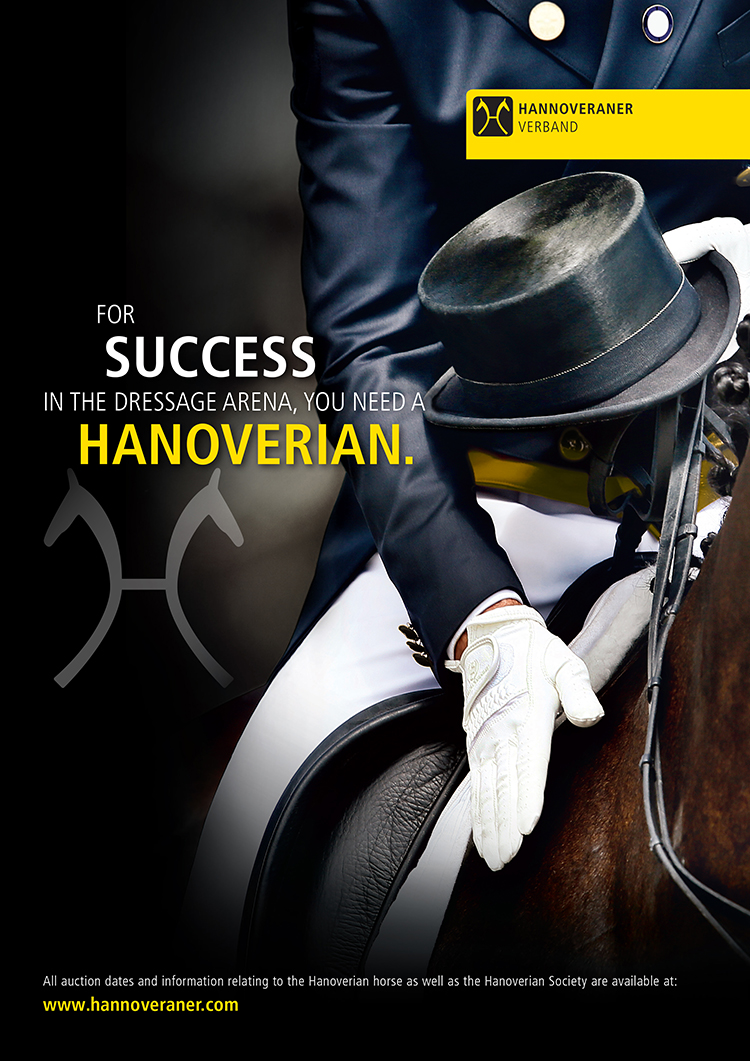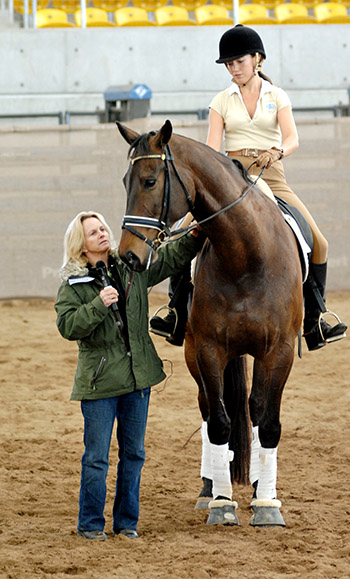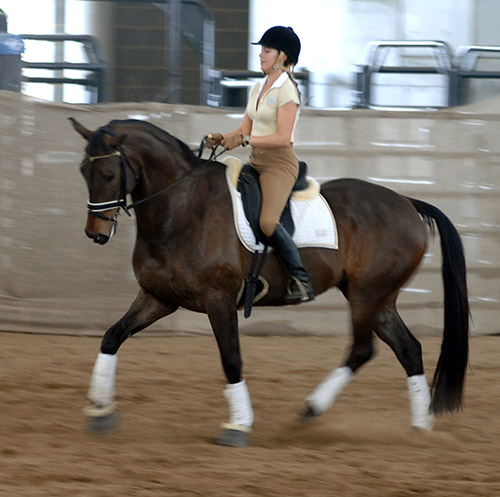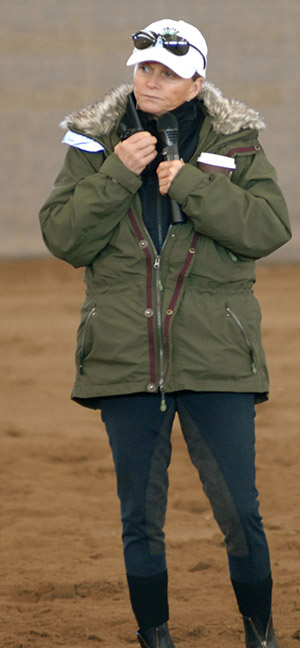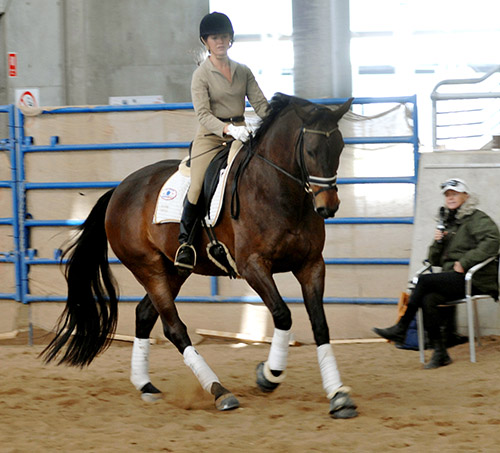Story by Shannan Makauskas Photos by Alex Makauskas
There are certain riders who appear so gifted you sometimes wonder if they know why they’re good at what they do, or if it simply comes naturally to them. These riders, despite being amongst the best in competition, are sometimes unable to transfer their success to their students. When George Morris instructed Bob McDonald, hunter/jumper trainer and husband of Debbie McDonald, at a showjumping clinic many years ago he commented that if Bob was to teach riders he would first need to figure out why he rode so well.
Bob was Debbie’s instructor when she was a 14 year old jumping rider, and she recalls how tough he was, but she also remembers how George Morris’ advice inspired them to change the way they trained and to become more compassionate teachers. With Debbie being named the 2009 United States Equestrian Federation ‘Developing Coach of the Year’, it’s a change that paid off. She now spends her time travelling the world to offer her expertise, Debbie adds: “My schedule is more hectic than ever.”
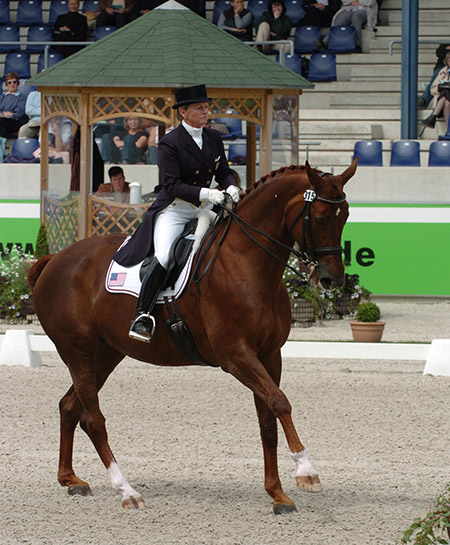
Debbie and the Hanovierian mare, Brentina, by Brentano
Achieving international stardom with the Hanoverian mare, Brentina, Debbie earned numerous team bronze and silver medals at World Championships and the Olympics as well as being the first American to win the World Cup Finals in 2003. It weas an amazing feat considering it was a series of bad jumping injuries that led Debbie to the Dressage arena in the first place.
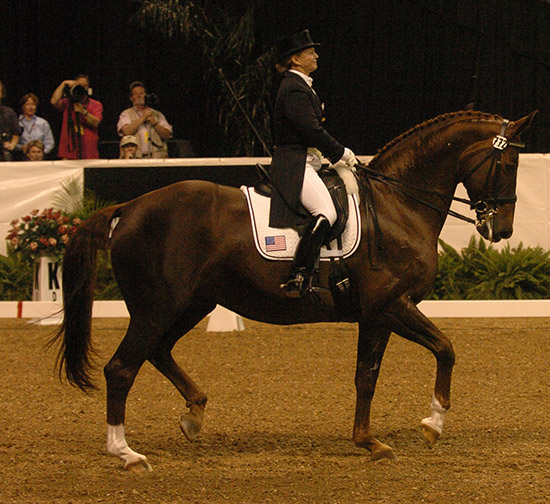
After 19 years of Dressage, Debbie rode in her first Olympics: “My success is attributed to hard work, dedication, a good supporting team of family, friends and peers, establishing a good basic foundation and lastly having access to the coaches I have been lucky enough to work with.” This includes world renowned trainers’ like Klaus Balkenhol, Hilda Gurney, Lilo Fore and Steffen Peters.
But all good things must come to an end, with Brentina and Debbie retiring from competition after the 2008 Beijing Olympics: “Unfortunately we didn’t do as well as we hoped. She was very frightened in the arena by the torch and the jumbotron.”
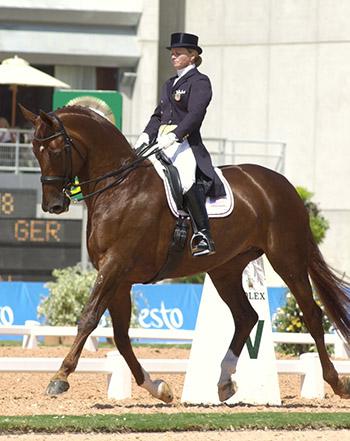
Members of the Silver Medal Team at the WEG in Spain
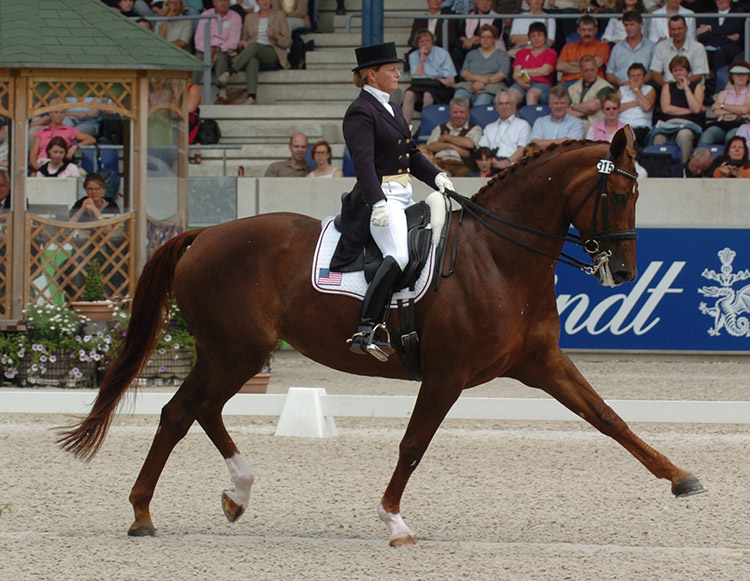
Kür starting with one handed extended trot at Aachen. One of their memorable Kürs ended with “Who could ask for anything more” – and you couldn’t have.
With Debbie celebrating her 55th birthday this year and Brentina turning 18, she decided it was time to move on: “When you’ve been competing at an elite level you don’t want to continue unless you can keep reproducing that. I wanted to end with Brentina and I wanted her to retire healthy.”
next the clinic in Australia
Brentina still has fans all over the world who marvel at her incredible nature and ability to perform, traits she will hopefully pass onto her foals: “We are expecting two Brentina babies in the coming season. She was bred to Damsey and also Leslie Morse’s Grand Prix stallion Kingston.”
Coaching has become Debbie’s passion in life and she insists it’s just as enjoyable as competing: “Yes absolutely, I enjoy being able to make a difference. But I do miss the behind the scenes of the competition world, the relationships and friendships made in the different places travelled.”
After the New South Wales Championships in Tamworth a handful of competitors made the effort to stay back and ride for three days under the watchful eye of Debbie McDonald. Ursula Vandeventer, who also lives in the United States, organised the clinic with the help of Jacqui van Bree.
Although they managed to fill the clinic they experienced some difficulties in getting the support they needed. According to Ursula: “It was very disappointing, the masterclass had to be cancelled due to insufficient attendance but those that did wish to attend instead enjoyed an evening meet-and-greet with Debbie over dinner where she answered questions. It seemed everybody had a great time.”
Much of the allure in having a lesson with Debbie resides in the fact that she’s only five foot tall and yet, masters the art of riding the big 17 hand plus Warmbloods. Ursula said at the clinic a lot of the lady riders’ run up shouting, “I’ve got short legs and a big horse, help!” For this reason I was excited to have a lesson with Debbie, being a somewhat small rider myself and currently training the 17 hand gelding, Goodtimes Solomon.
With a relentless downpour and a mighty gale blowing through the indoor it was the perfect opportunity to get Debbie’s tips on warming-up a tense horse. We began the lesson in walk, familiarizing the horse with aids that would later be used in trot. Debbie says: “This is a big horse, but he’s narrow enough to work with. As long as you can get him sensitive and he listens to you, the size doesn’t matter so much. The secret to riding the strong ones is constant half halts.”
Everytime the horse pulls on the contact or rushes in the rhythm, Debbie asks me to ride haunches-in until I have his attention. In effect, this acts like a half-halt by rebalancing the horse’s weight onto the hind legs, as well as making him listen to my aids without me pulling on the reins and blocking: “We only want to ride in the travers for as short a time as possible, just ask and when he answers you relax again.”
The aim is to only ride the travers for a stride and eventually just squeeze the outside rein momentarily to gain the horse’s attention. It’s perfect for that moment when you feel the horse grab the reins and take control. You can pull and tug all you want but why not make things a lot easier and put him in travers? It instantly brings them into a collected stride without too much interference from the rein. Debbie pointed out the benefits of using a lateral movement to regain the horse’s attention: “If you just pull to slow down you’re blocking the hind legs. If we put him a little haunches-in at least we’re doing something with the back end and he can’t run away.”
We pick-up the trot work and apply the same exercises we did in the walk; riding travers momentarily until the rhythm becomes more regular. Then we are straight into the half halts: “Even in the warm-up every once and a while do transitions within the trot. Sometimes just bring him back towards thinking one or two steps in passage.”
next came half halts
But riding half halts on a strong, tense horse is not easy to do without pulling on the reins. Debbie says: “Keep him in the lateral movement when you touch him with the whip behind. That way you can soften your hand without him running away.”
We then ride some shoulder-in down the long side with Debbie noting how my horse seems determined to stay on the wall: “He needs to learn to go wherever you put him and be straight.”
We are then instructed to ride off the wall so as to keep him from using it as a guide rather than listening my aids and as Debbie predicted, he’s falling through the outside shoulder. So we ride in minor counter-flexion for just a few strides. When he comes straight we continue with the shoulder-in: “Now ride some transitions throughout the shoulder-in and tickle him with the whip behind. Don’t lose the quality of the trot in the lateral movement. Just bring him back, tuk tuk with the whip behind to get him a little quicker, now relax.”
Now, instead of just using a travers to regulate the rhythm we use a stride ridden in minor counter-flexion to rebalance him every few strides. With Debbie, every aid and change in positioning is subtle and slight. Debbie notes: “Don’t over-do the counter-flexion. It makes the horse even less straight than he was to begin with. You have to make the right position the most comfortable one so they want to stay there.”
She also reminds me regularly to relax my lower back and arms, as the tension in my body can influence the horse to hold his back. Everytime he gives me the right reaction I have to relax through my body and as Debbie says, “Make it comfortable for him to stay that way.” We end the lesson and I’m looking forward to picking up where we left off, the following day.
The bad weather has not ceased overnight and we enter the arena in similar circumstances to the first day. This time however, Debbie has a new idea to keep my horse’s focus on me. We ride in trot and later in canter on a straight line 10 metres off the wall. I wait for my horse to try to run or come heavy on the contact and when he does, I’m instructed to ride a turn toward the wall, which is more like a half 10 metre circle. Then we ride on a diagonal line until I’m 10 metres off the wall so I’m able to repeat the exercise if my horse gets strong again.
In effect this allows you to shift some weight onto the hind legs without pulling on the rein and blocking the energy from behind. Furthermore, Debbie says: “This will make him wait for you. He never knows when he’ll be asked to turn and being such a big horse it’s a considerable effort to make the turn so he starts listening and waiting for your aids.” I’m surprised to find this has regulated his rhythm and he is no longer grabbing the reins and attempting to flee the vicinity every few strides.
As with the travers, Debbie likes to vary the exercises so the horse never gets the opportunity to plot ways of getting out of it: “We can do it this way but don’t do it too much or he’ll find a way to avoid it.”
Debbie asks me to ride in sitting trot and we attempt to do some half halts: “The half halt is the most misunderstood tool in training. People always ride them so slow and stay in them for so long, waiting for something to happen. They’re not sure what is supposed to happen but they wait for something and then ride back out, having achieved nothing. The key to riding a good half halt is in the timing. It’s more or less just a rebalancing of the energy onto the hind legs and then a release. It should be so quick no one even notices it. It’s just a ‘tuk, tuk’ with your outside rein and off you go.”
Trotting on a 15 metre circle we ride the half halt with Debbie reminding me: “Keep the flexion in the transitions so he stays soft.” The next obstacle is keeping the activity when I bring him back: “You’re lucky to have a horse with such an active hind leg so you want to really use this in the half halt, think more passage.”
“If you’ve had to give them a kick to get off your leg, really leave him alone afterwards. Make it comfortable for him to stay in this trot. You want to be able to relax your leg, so ask and as soon as he answers you relax.”
Then it’s onto the canter work with more half halts: “He has such a big jump in the canter that when you come into the half halt you hold him in it for too long and he starts climbing. Just rock him back, now haunches in and tickle him behind, good pat him.”
Debbie is meticulous with the timing of the aids. Much like the pressure release training of Andrew McLean and every other great training system around the world, you must reward the correct attempt as soon as it’s given: “When he answers you make it comfortable, he likes it in this position and if we make it easy for him he’ll stay there.”
Debbie, like other International trainers who come to Australia, shows there are no quick fixes or insider secrets. But unlike some of those Germans who turn up, with legs up to their armpits and a painstakingly perfect position, Debbie proves where there’s a will there’s a way and she is a trainer intelligent enough to show us how.



